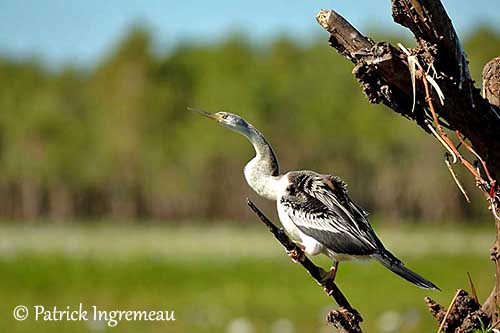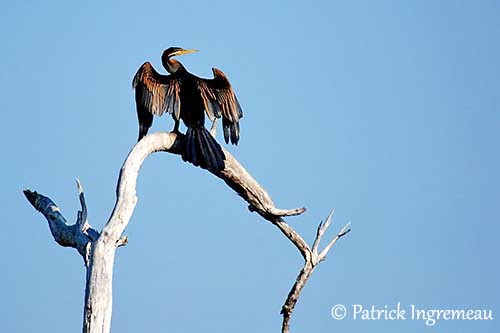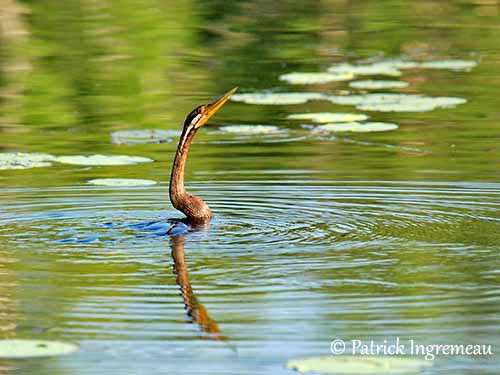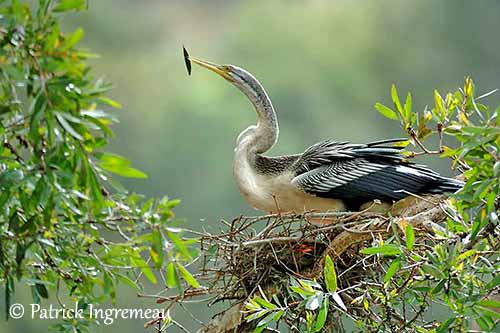
Australian Darter
Anhinga novaehollandiae
Suliformes Order – Anhingidae Family
BIOMETRICS:
Lenght : 85-90 cm
Weight : 2600 g
LONGEVITY: Up to 15 years
DESCRIPTION:
Australian darter, as other darters, is also named “snake-bird”, due to its long, thin neck, giving it a snake-like appearance when swimming into water with submerged body.
Adult male has dark brownish-black plumage overall, but breast is dark chestnut-brown. Upper wings are very glossy black, with white, silver-grey and brown streaks and spots. Long, rounded tail is shiny grey-black.
Head and long, thin neck are black. We can see whitish stripe on face, from base of the bill, through the cheeks to upper sides of the neck.
Long, pointed bill is yellow. Eyes are yellowish. Legs and webbed feet are flesh coloured.
Fr: Anhinga d’Australie
All : Australien- Schlangenhalsvogel
Esp : Anhinga Australiana
Ital : Aninga australiana
Nd : Australische Slangenhalsvogel
Photographs by Patrick Ingremeau
TAMANDUA
Text by Nicole Bouglouan
Sources:
HANDBOOK OF THE BIRDS OF THE WORLD vol 1 by Josep del Hoyo-Andrew Elliot-Jordi Sargatal - Lynx Edicions - ISBN: 8487334105
Birds in backyards (Birds Australia and Australian Museum)
Wikipedia (Wikipedia, The Free Encyclopedia)
We can find two main species.
Anhinga anhinga is found in North America.
Anhinga melanogaster is now divided in 3 subspecies such as:
Anhinga rufa in Africa;
Anhinga melanogaster in South Asia;
Anhinga novaehollandiae in New Guinea and Australia.
VOICE: SOUNDS BY XENO-CANTO
Australian Darter is usually silent. When at nest, male utters varied sounds such as caws, hisses and clicks. Away from the nest, it utters clicking sounds.
HABITAT:
Australian Darter lives in wetlands and sheltered bays. It favours fresh, open waters with tree trunks, stumps or branches just at water level, for resting and drying its wings.
It is often seen inland, near water, but it is also seen fishing in quiet areas, near the shores. But its preferred habitat is subtropical and tropical mangroves.
FLIGHT:
Australian Darter flies gracefully, soaring at great heights on thermals, and gliding into the air. It can move over long distances, up to 2000 km, outside of breeding season.
REPRODUCTION:
Australian Darters form pairs only for breeding, when water levels and food resources are correct. Usually, this species breeds in spring and summer.
Australian Darter nests in solitary or in small colonies with other aquatic bird species nesting in trees.
Male prepares the nest-site with green leafy sticks, and performs some displays, in order to attract a female. Displays consist in wing-waving and twig-grasping movements.
Female lays 2 to 6 eggs. Incubation lasts about 28 days, shared by both parents.
Chicks are often brooded for keep them warm, or cooled down with an adult spreading its open wings above them. Parents perform these behaviours during one week after hatching, and at night, both adults remain at nest with the chicks. If weather is too hot, adults shake their feathers over the chicks after swimming.
Young are able to swim at about 4 weeks of age, and they start to fly at about 50 days old.
DIET:
Australian Darter feeds mainly on fish, but it also consumes insects and aquatic animals such as tortoises, and some vegetation.
PROTECTION / THREATS / STATUS:
Australian Darters are threatened by changes in their habitat, such as drainage of wetlands, increase of salinity, clearing of vegetation, grazing, and increase of fire frequency.
They are often disturbed by duck-shooting, and they may loose their eggs. Adults are sometimes trapped in fishing nets.


RANGE:
Australian Darter is found in Australia, Indonesia, New Zealand and Papua New Guinea.
BEHAVIOUR:
Australian Darter, as other darters, is often seen perched on branch or stumps above water, drying its open wings. It swims with submerged body, with only head and neck visible above water, as a snake.


It is fairly clumsy when walking on land.
It is often found with cormorants, but its slender body and its long neck differ from these bulkier birds.
Australian Darter feeds in fresh, open waters with sparse vegetation, in order to dive and swim easily. It feeds on aquatic animals, catching them with its sharp semi-open bill, and diving deeper than 60 cm. prey is pierced from below, flicked onto the surface, and swallowed head first. It may eat smaller items underwater, but larger preys are carried to a perch.
Australian darter is a solitary bird, forming pairs only at breeding season.




